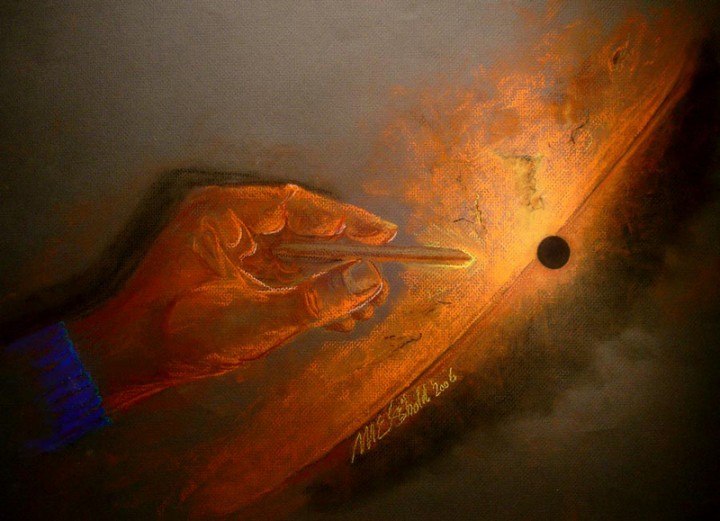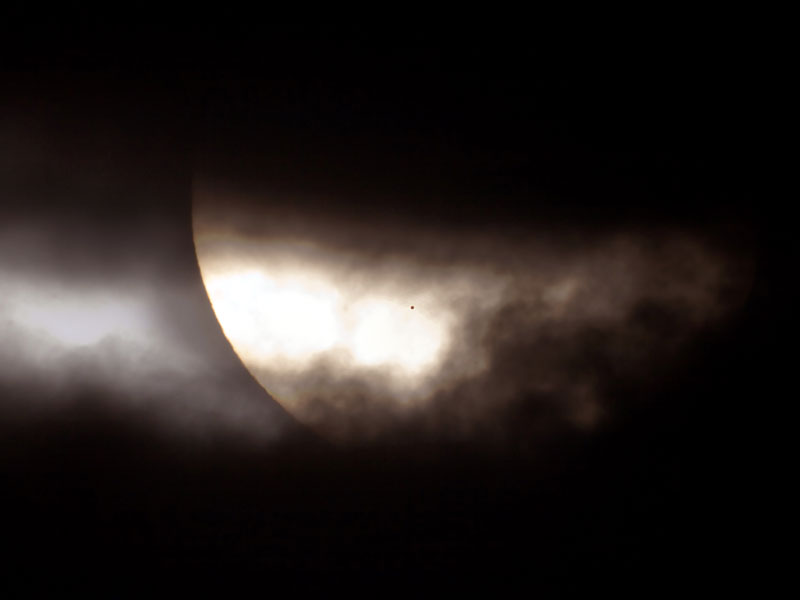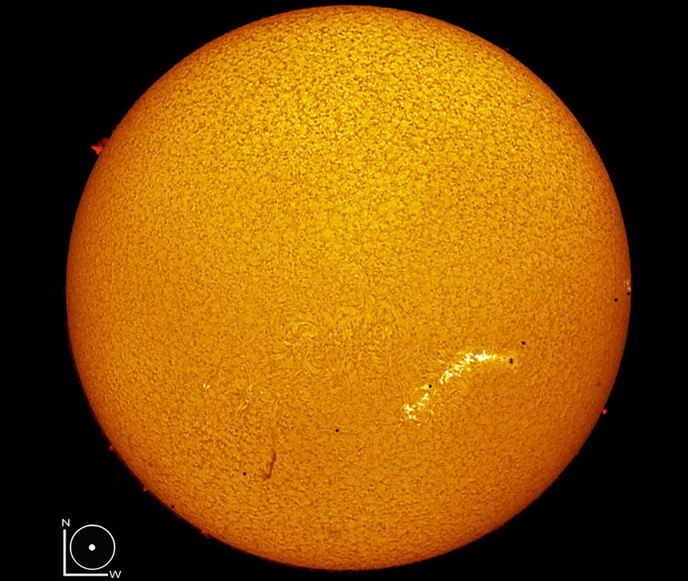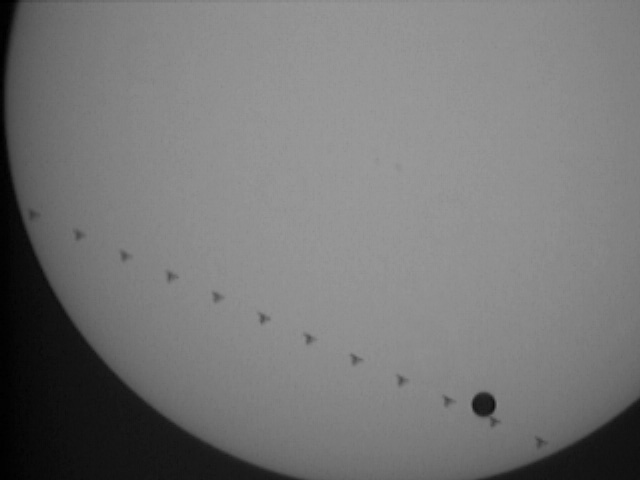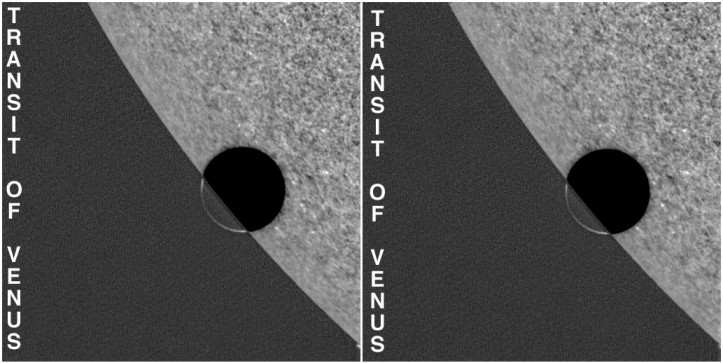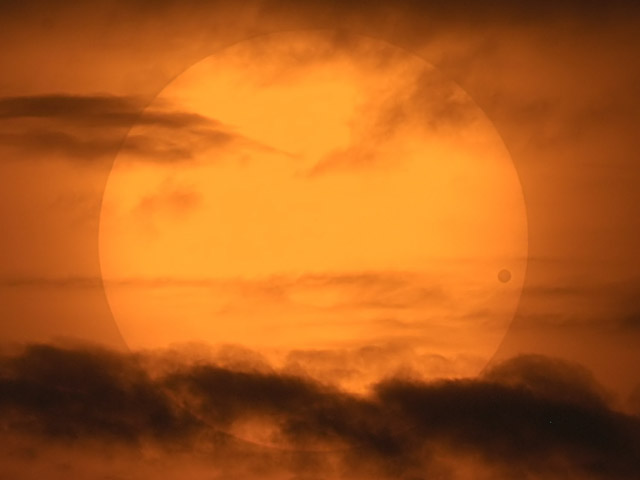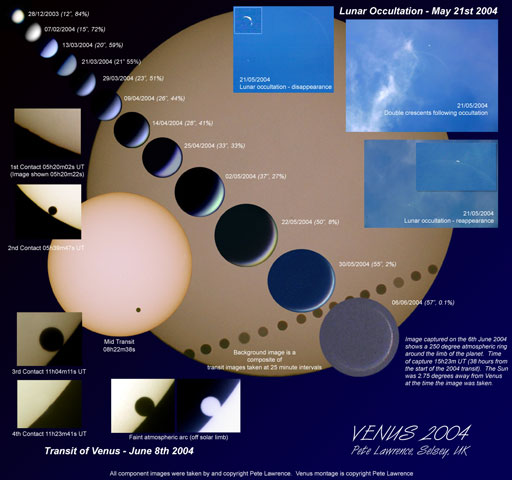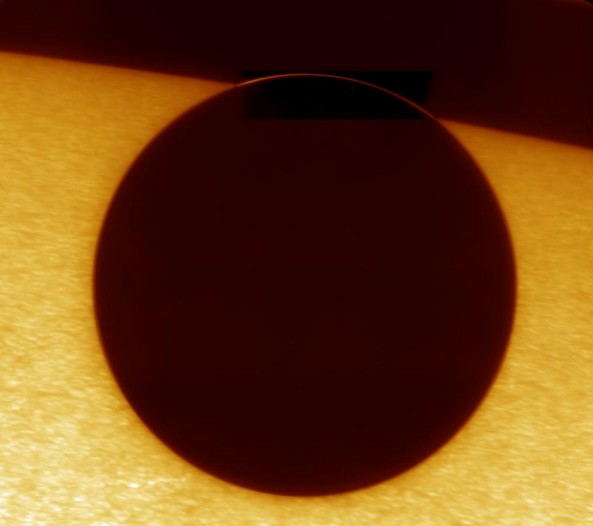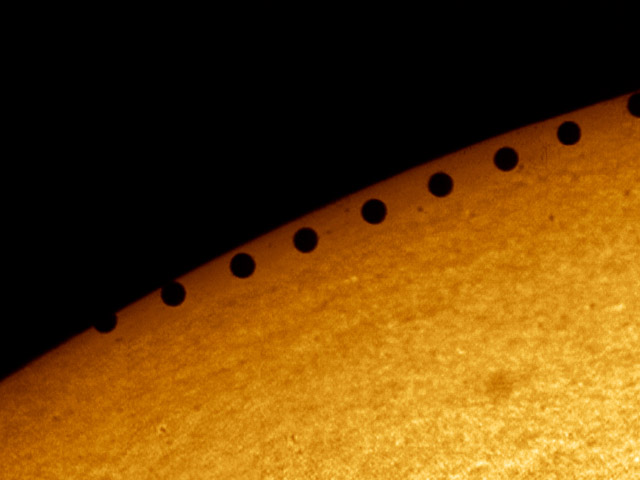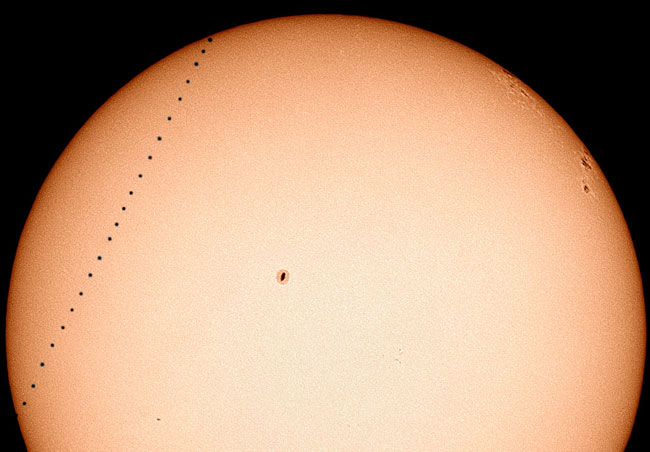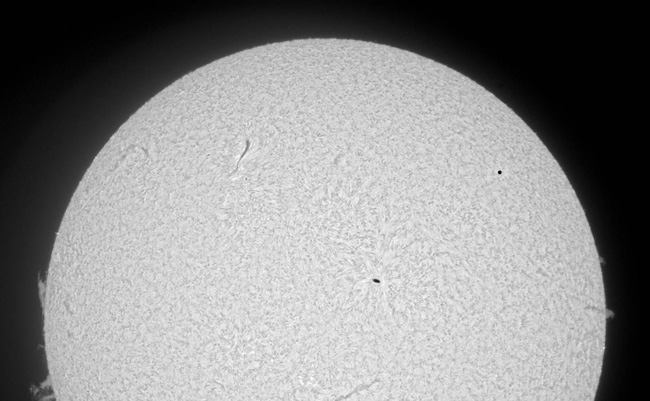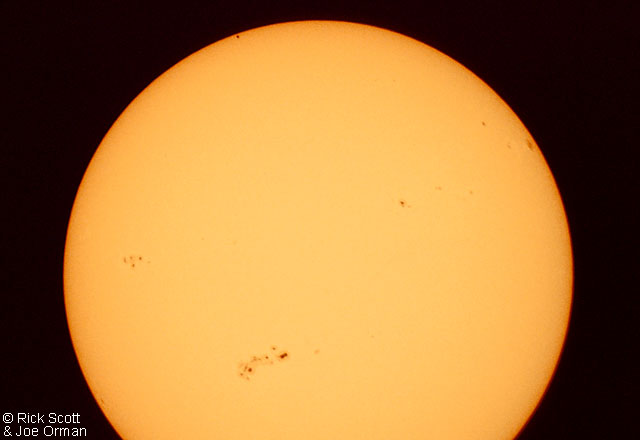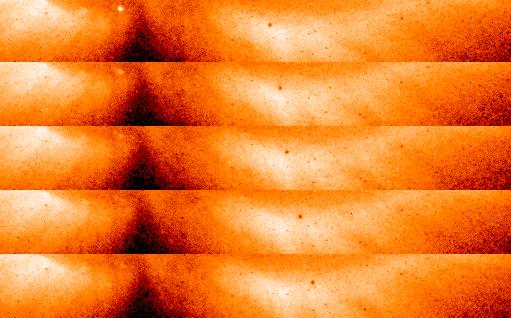APOD Collection: Mercury and Venus Transits
APOD Collection: Mercury and Venus Transits
Mercury and Venus Transits
All titles are clickable and link to the original APOD page. Click on an image for a larger view of it.
2006 November 25 Mercury is now visible shortly before dawn, the brightest "star" just above the eastern horizon. But almost two weeks ago Mercury actually crossed the face of the Sun for the second time in the 21st century. Viewed with red/blue glasses, this stereo anaglyph combines space-based images of the Sun and innermost planet in a just-for-fun 3D presentation of the Mercury transit. The solar disk image is from Hinode. (sounds like "hee-no-day", means sunrise). A sun-staring observatory, Hinode was launched from Uchinoura Space Center and viewed the transit from Earth orbit. Superimposed on Mercury's dark silhouette is a detailed image of the planet's rugged surface based on data from the Mariner 10 probe that flew by Mercury in 1974 and 1975.
2006 November 17 The sight of Mercury's tiny round disk drifting slowly across the face of the Sun inspired and entertained many denizens of planet Earth last week. In fact, artist and astronomer Mark Seibold viewed both the 1999 and 2006 transits of the solar system's innermost planet through solar filtered telescopes and composed this rendering of Mercury "hovering in the photosphere" near the edge of an enormous solar disk. The original work is a 23 by 17 inch pastel sketch. While the artist's hand is creatively superimposed, Seibold concentrated on offering an impression of Mercury's silhouette, surrounded by shadings reflecting his visual experience that are not easily captured in photographic exposures. Of course, before the age of cameras drawings were more widely used to record telescopic observations of sunspots and planetary transits.
2006 November 14 What's that dot on the Sun? If you look closely, it is almost perfectly round. The dot is the result of an unusual type of solar eclipse that occurred last week. Usually it is the Earth's Moon that eclipses the Sun. Last week, for the first time in over three years, the planet Mercury took a turn. Like the approach to New Moon before a solar eclipse, the phase of Mercury became a continually thinner crescent as the planet progressed toward an alignment with the Sun. Eventually the phase of Mercury dropped to zero and the dark spot of Mercury crossed our parent star. The situation could technically be labeled a Mercurian annular eclipse with an extraordinarily large ring of fire. From above the cratered planes of the night side of Mercury, the Earth appeared in its fullest phase. Hours later, as Mercury continued in its orbit, a slight crescent phase appeared again. The next Mercurian solar eclipse will occur in 2016.
2006 November 10 Enjoying Wednesday's transit of Mercury from Dallas, Texas, astronomer Phil Jones recorded this detailed image of the Sun. Along with a silhouette of the innermost planet, a network of cells and dark filaments can be seen against a bright solar disk with spicules and prominences along the Sun's edge. The composited image was taken through a telescope equiped with an H-alpha filter that narrowly transmits only the red light from hydrogen atoms. Such images emphasize the solar chromosphere, the region of the Sun's atmosphere immediately above its photosphere or normally visible surface. Left of center, the tiny disk of Mercury seems to be imitating a small sunspot that looks a little too round. But in H-alpha pictures, sunspot regions are usually dominated by bright splotches (called plages) on the solar chromosphere.
2006 November 8 Mercury, the solar system's innermost planet, will spend about five hours crossing in front of the Sun today - beginning at 1912 UT (2:12pm EST), November 8. Specially equipped telescopes are highly recommended to safely spot the planet's diminutive silhouette however, as Mercury should appear about 200 times smaller than the enormous solar disk. This simulated view is based on a filtered solar image recorded on November 3rd. It shows active regions and the Mercury transit across the Sun at six positions from lower left to middle right. Depending on your location, the Sun may not be above the horizon during the entire transit, but webcasts of the event are planned - including one using images from the sun-staring SOHO spacecraft. This is the second of 14 transits of Mercury during the 21st century. The next similar event will be a transit of Venus in June of 2012.
2004 July 20 On June 8, Venus was not the only celestial object to pass in front of the Sun. A few well-situated photographers caught the International Space Station also crossing the Sun simultaneously. Pictured above is a unique time-lapse image of the unprecedented double transit, a rare event that was visible for less than a second from a narrow band on Earth. The above image is a combination of 12 frames taken 0.033 seconds apart and each themselves lasting only 1/10,000 th of a second. The image was taken from the small village of Stupava in Slovakia. The next time Venus will appear to cross the Sun from Earth will be in 2012.
2004 July 17 Venus glides in front of an enormous solar disk in these two frames from the TRACE satellite imaging of the inner planet's 2004 transit. Arranged in a "right/left" stereogram, the frames are intended to be viewed at a comfortable distance from the screen with your eyes gently crossed, allowing the images to merge and produce a pleasing stereo effect. Shown during the ingress (beginning) phase of the transit, the silhouetted portion of the planet appears to float dramatically in front of the Sun's granulated surface. Of course, the dense Cytherian (Venusian) atmosphere also scatters and refracts the intense sunlight. The effect is visible across the portion of the planet still beyond the Sun's edge and viewed against the blackness of space.
2004 June 23 The rare transit of Venus across the face of the Sun earlier this month was one of the better-photographed events in sky history. Both scientific and artistic images have been flooding in from the areas that could see the transit: Europe and much of Asia, Africa, and North America. Scientifically, solar photographers confirmed that the black drop effect is really better related to the viewing clarity of the camera or telescope than the atmosphere of Venus. Artistically, images might be divided into several categories. One type captures the transit in front of a highly detailed Sun. Another category captures a double coincidence such as both Venus and an airplane simultaneously silhouetted, or Venus and the International Space Station in low Earth orbit. A third image type involves a fortuitous arrangement of interesting looking clouds, as shown by example in the above image taken from North Carolina, USA. There the distant orb of giant Venus might have been mistaken, at first glance, for a small but unusually circular cloud.
2004 June 15 An unusual type of solar eclipse occurred last week. Usually it is the Earth's Moon that eclipses the Sun. Last week, for the first time in over 100 years, the planet Venus took a turn. Like a solar eclipse by the Moon, the phase of Venus became a continually thinner crescent as Venus became increasingly better aligned with the Sun. Eventually the alignment became perfect and the phase of Venus dropped to zero. The dark spot of Venus crossed our parent star. The situation could technically be labeled a Venusian annular eclipse with an extraordinarily large ring of fire. From above the thick cloud tops of Venus, the Earth appeared in its fullest phase, brighter in the Venusian sky than even Mars appeared from Earth last August. Hours later, as Venus continued in its orbit, a slight crescent phase appeared again. The next Venusian solar eclipse will occur in 2012.
2004 June 11 Enjoying the 2004 Transit of Venus from Stuttgart, Germany, astronomer Stefan Seip recorded this fascinating, detailed image of the Sun. Revealing a network of cells and dark filaments against a bright solar disk with spicules and prominences along the Sun's limb, his telescopic picture was taken through an H-alpha filter. The filter narrowly transmits only the red light from hydrogen atoms and emphasizes the solar chromosphere -- the region of the Sun's atmosphere immediately above its photosphere or normally visible surface. Here, the dark disk of Venus seems to be imitating a giant sunspot that looks perhaps a little too round. But in H-alpha pictures like this one, sunspot regions are usually dominated by bright splotches (called plages) on the solar chromosphere.
2004 June 10 With Venus in transit at the Sun's edge on June 8th, astronomers captured this tantalizing close-up view of the bright solar surface and partially silhouetted disk. Enhanced in the sharp picture, a delicate arc of sunlight refracted through the Venusian atmosphere is also visible outlining the planet's edge against the blackness of space. The arc is part of a luminous ring or atmospheric aureole, first noted and offered as evidence that Venus did posses an atmosphere following observations of the planet's 1761 transit. The image was recorded using the 1-meter Swedish Solar Telescope located on La Palma in the Canary Islands. For the Institute for Solar Physics, Dan Kiselman, Goran Scharmer, Kai Langhans, and Peter Dettori were at the telescope, while Mats Lofdahl produced the final image. Excellent movies of the transit - including one of the emergence of Venus' atmospheric aureole - are available from the Dutch Open Telescope, also observing from La Palma.
2004 June 9 Did you see the transit? While some watched by webcast, sky gazers in Europe, the Middle East, Africa, and Asia were able to witness the complete 6 hour journey of Venus' silhouetted disk across the face of the Sun. As seen from North America, the much heralded Venus Transit of 2004 was nearing its final stages at sunrise yesterday in this telescopic image. The view looks across the Atlantic from Tybee Island near Savannah, Georgia, USA. In fact, many in eastern North America experienced a dramatic view of a perfect, dark, round Venus against a reddened Sun filtered by banks of low clouds. Ironically, the Sun takes on the appearance of a cloud covered planet itself as Venus marches toward the right through this dreamlike scene.
2004 June 8 Today an astronomical event will occur that no living person has ever seen: Venus will cross directly in front of the Sun. A Venus crossing, called a transit, last occurred in 1882 and was front-page news around the world. Today's transit will be visible in its entirety throughout Europe and most of Asia and Africa. The northeastern half of North America will see the Sun rise with the dark dot of Venus already superposed. Never look directly at the Sun, even when Venus is in front. Mercury's closer proximity to the Sun cause it to transit every few years. In fact, the above image mosaic of Mercury crossing the Sun is from two transits ago, in November 1999. Will anyone living see the next Venus transit? Surely yes since it occurs in 2012.
2003 May 27 Earlier this month, the planet Mercury crossed the face of the Sun, as seen from Earth. Because the plane of Mercury's orbit is not exactly coincident with the plane of Earth's orbit, Mercury usually appears to pass over or under the Sun. The above time-lapse sequence, superimposed on a single frame, was taken from a balcony in Belgium on May 7 and shows the entire transit. The solar crossing lasted over five hours, so that the above 23 images were taken roughly 15 minutes apart. The north pole of the Sun, the Earth, Mercury's orbit, although all different, all occur in directions slightly above the left of the image. Near the center and on the far right, sunspots are visible.
2003 May 13 How big is the Sun? The Sun is not only larger than any planet, it is larger than all of the planets put together. The Sun accounts for about 99.9 percent of all the mass in its Solar System. Merely stating the Sun's diameter is about 1,400,000 kilometers does not do it justice. Last week a chance to gain visual size perspective occurred when planet Mercury made a rare crossing in front to Sun. Mercury, a planet over a third of the diameter of our Earth, is the dark dot on the upper right. In comparison to the Sun, Mercury is so small it is initially hard to spot. Also visible on the Sun are dark circular sunspots, bright plages, and dark elongated prominences -- many of which are larger than Mercury. The above contrast-enhanced picture was captured last week from France.
2003 May 8 Can you spot the planet? The diminutive disk of Mercury, the solar system's innermost planet, spent about five hours crossing in front of the enormous solar disk yesterday (Wednesday, May 7th), as viewed from the general vicinity of planet Earth. The Sun was above the horizon during the entire transit for observers in Europe, Africa, Asia, or Australia, and the horizon was certainly no problem for the sun-staring SOHO spacecraft. Seen as a dark spot, Mercury progresses from left to right (top panel to bottom) in these four images from SOHO's extreme ultraviolet camera. The panels' false-colors correspond to different wavelengths in the extreme ultraviolet which highlight regions above the Sun's visible surface. This is the first of 14 transits of Mercury which will occur during the 21st century, but the next similar event will be a transit of Venus in June of 2004. Need help spotting Mercury? Just click on the picture.
December 10, 1999 OK, it's a picture of the Sun (duh!), but can you spot the planet? Of course, most of the spots you've spotted are sunspots, as large or larger than planet Earth itself. The sunspots are regions of strong surface magnetic fields which are dark in this picture only because they are relatively cool compared to their surroundings. Over the past few years, the number of sunspots has been steadily increasing as the Sun approaches the maximum in its 11 year activity cycle. But also visible in this photograph from November 15, is planet Mercury. At just over 1/3 Earth's size, Mercury is passing in front of the Sun, its silhouette briefly creating a diminutive dark spot drifting across an enormous solar disk. While "transits" of Mercury do occur 13 times a century, this one was additionally a very rare grazing transit of our Solar System's innermost planet. Spotted Mercury yet? Click on the picture for a hint.
November 19, 1999 Just days before the peak of the Leonid meteor shower, skywatchers were offered another astronomical treat as planet Mercury crossed the face of the Sun on November 15. Viewed from planet Earth, a transit of Mercury is not all that rare. The last occurred in 1993 and the next will happen in 2003. Enjoying a mercurial transit does require an appropriately filtered telescope, still the event can be dramatic as the diminutive well-done world drifts past the dominating solar disk. This slow loading gif animation is based on images recorded by the earth-orbiting TRACE satellite. The false-color TRACE images were made in ultraviolet light and tend to show the hot gas just above the Sun's visible surface. Mercury's disk is silhouetted against the seething plasma as it follows a trajectory near the edge of the Sun.
July 2, 1998 This sequence of false color X-ray images captures a rare event - the passage or transit of planet Mercury in front of the Sun. Mercury's small disk is silhouetted against the bright background of X-rays from the hot Solar Corona. It appears just to the right of center in the top frame and moves farther right as the sequence progresses toward the bottom. The dark notch is a coronal hole near the Solar South Pole, while a flaring coronal bright point can be seen to the left of the notch in the top frames. The frames were recorded on November 6, 1993 by the Soft X-ray Telescope on board the orbiting Yohkoh satellite. Transits of Mercury (and Venus) were historically used to discover the geometry of the solar system and to map planet Earth itself.
A closed mouth gathers no foot.

